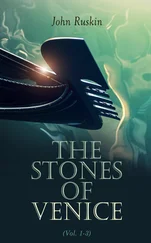John Ruskin - The Stones of Venice, Volume 1 (of 3)
Здесь есть возможность читать онлайн «John Ruskin - The Stones of Venice, Volume 1 (of 3)» — ознакомительный отрывок электронной книги совершенно бесплатно, а после прочтения отрывка купить полную версию. В некоторых случаях можно слушать аудио, скачать через торрент в формате fb2 и присутствует краткое содержание. Жанр: foreign_antique, foreign_home, architecture_book, literature_19, visual_arts, на английском языке. Описание произведения, (предисловие) а так же отзывы посетителей доступны на портале библиотеки ЛибКат.
- Название:The Stones of Venice, Volume 1 (of 3)
- Автор:
- Жанр:
- Год:неизвестен
- ISBN:нет данных
- Рейтинг книги:4 / 5. Голосов: 1
-
Избранное:Добавить в избранное
- Отзывы:
-
Ваша оценка:
- 80
- 1
- 2
- 3
- 4
- 5
The Stones of Venice, Volume 1 (of 3): краткое содержание, описание и аннотация
Предлагаем к чтению аннотацию, описание, краткое содержание или предисловие (зависит от того, что написал сам автор книги «The Stones of Venice, Volume 1 (of 3)»). Если вы не нашли необходимую информацию о книге — напишите в комментариях, мы постараемся отыскать её.
The Stones of Venice, Volume 1 (of 3) — читать онлайн ознакомительный отрывок
Ниже представлен текст книги, разбитый по страницам. Система сохранения места последней прочитанной страницы, позволяет с удобством читать онлайн бесплатно книгу «The Stones of Venice, Volume 1 (of 3)», без необходимости каждый раз заново искать на чём Вы остановились. Поставьте закладку, и сможете в любой момент перейти на страницу, на которой закончили чтение.
Интервал:
Закладка:
CHAPTER IX.
THE CAPITAL
§ I. The reader will remember that in Chap. VII.§ V. it was said that the cornice of the wall, being cut to pieces and gathered together, formed the capital of the column. We have now to follow it in its transformation.
We must, of course, take our simplest form or root of cornices ( a , in Fig. V., above). We will take X and Y there, and we must necessarily gather them together as we did Xb and Yb in Chap. VII.Look back to the tenth paragraph of Chap. VII., read or glance it over again, substitute X and Y for Xb and Yb, read capital for base, and, as we said that the capital was the hand of the pillar, while the base was its foot, read also fingers for toes; and as you look to the plate, Fig. XII., turn it upside down. Then h , in Fig. XII., becomes now your best general form of block capital, as before of block base.
§ II. You will thus have a perfect idea of the analogies between base and capital; our farther inquiry is into their differences. You cannot but have noticed that when Fig. XII.is turned upside down, the square stone (Y) looks too heavy for the supporting stone (X); and that in the profile of cornice ( a of Fig. V.) the proportions are altogether different. You will feel the fitness of this in an instant when you consider that the principal function of the sloping part in Fig. XII.is as a prop to the pillar to keep it from slipping aside ; but the function of the sloping stone in the cornice and capital is to carry weight above . The thrust of the slope in the one case should therefore be lateral, in the other upwards.
§ III. We will, therefore, take the two figures, e and h of Fig. XII., and make this change in them as we reverse them, using now the exact profile of the cornice a ,—the father of cornices; and we shall thus have a and b , Fig. XIX.
Fig. XIX.

Both of these are sufficiently ugly, the reader thinks; so do I; but we will mend them before we have done with them: that at a is assuredly the ugliest,—like a tile on a flower-pot. It is, nevertheless, the father of capitals; being the simplest condition of the gathered father of cornices. But it is to be observed that the diameter of the shaft here is arbitrarily assumed to be small, in order more clearly to show the general relations of the sloping stone to the shaft and upper stone; and this smallness of the shaft diameter is inconsistent with the serviceableness and beauty of the arrangement at a , if it were to be realised (as we shall see presently); but it is not inconsistent with its central character, as the representative of every species of possible capital; nor is its tile and flower-pot look to be regretted, as it may remind the reader of the reported origin of the Corinthian capital. The stones of the cornice, hitherto called X and Y, receive, now that they form the capital, each a separate name; the sloping stone is called the Bell of the capital, and that laid above it, the Abacus. Abacus means a board or tile: I wish there were an English word for it, but I fear there is no substitution possible, the term having been long fixed, and the reader will find it convenient to familiarise himself with the Latin one.
§ IV. The form of base, e of Fig. XII., which corresponds to this first form of capital, a, was said to be objectionable only because it looked insecure; and the spurs were added as a kind of pledge of stability to the eye. But evidently the projecting corners of the abacus at a , Fig. XIX., are actually insecure; they may break off, if great weight be laid upon them. This is the chief reason of the ugliness of the form; and the spurs in b are now no mere pledges of apparent stability, but have very serious practical use in supporting the angle of the abacus. If, even with the added spur, the support seems insufficient, we may fill up the crannies between the spurs and the bell, and we have the form c
Конец ознакомительного фрагмента.
Текст предоставлен ООО «ЛитРес».
Прочитайте эту книгу целиком, купив полную легальную версию на ЛитРес.
Безопасно оплатить книгу можно банковской картой Visa, MasterCard, Maestro, со счета мобильного телефона, с платежного терминала, в салоне МТС или Связной, через PayPal, WebMoney, Яндекс.Деньги, QIWI Кошелек, бонусными картами или другим удобным Вам способом.
1
Appendix 1, “Foundation of Venice.”
2
Appendix 2, “Power of the Doges.”
3
Sismondi, Hist. des Rép. Ital., vol. i. ch. v.
4
Appendix 3, “Serrar del Consiglio.”
5
“Ha saputo trovar modo che non uno, non pochi, non molti, signoreggiano, ma molti buoni, pochi migliori, e insiememente, un ottimo solo .” ( Sansovino. ) Ah, well done, Venice! Wisdom this, indeed.
6
Daru, liv. xii. ch. xii.
7
Daru, liv. xvi. cap. xx. We owe to this historian the discovery of the statutes of the tribunal and date of its establishment.
8
Ominously signified by their humiliation to the Papal power (as before to the Turkish) in 1509, and their abandonment of their right of appointing the clergy of their territories.
9
The senate voted the abdication of their authority by a majority of 512 to 14. (Alison, ch. xxiii.)
10
By directing the arms of the Crusaders against a Christian prince. (Daru, liv. iv. ch. iv. viii.)
11
Appendix 4, “San Pietro di Castello.”
12
Tomaso Mocenigo, above named, § V.
13
“In that temple porch,
(The brass is gone, the porphyry remains,)
Did Barbarossa fling his mantle off,
And kneeling, on his neck receive the foot
Of the proud Pontiff—thus at last consoled
For flight, disguise, and many an aguish shake
On his stone pillow.”
I need hardly say whence the lines are taken: Rogers’ “Italy” has, I believe, now a place in the best beloved compartment of all libraries, and will never be removed from it. There is more true expression of the spirit of Venice in the passages devoted to her in that poem, than in all else that has been written of her.
14
At least, such success as they had. Vide Appendix 5, “The Papal Power in Venice.”
15
The inconsiderable fortifications of the arsenal are no exception to this statement, as far as it regards the city itself. They are little more than a semblance of precaution against the attack of a foreign enemy.
16
Mémoires de Commynes, liv. vii. ch. xviii.
17
Appendix 6, “Renaissance Ornaments.”
18
Appendix 7, “Varieties of the Orders.”
19
The reader will find the weak points of Byzantine architecture shrewdly seized, and exquisitely sketched, in the opening chapter of the most delightful book of travels I ever opened,—Curzon’s “Monasteries of the Levant.”
Читать дальшеИнтервал:
Закладка:
Похожие книги на «The Stones of Venice, Volume 1 (of 3)»
Представляем Вашему вниманию похожие книги на «The Stones of Venice, Volume 1 (of 3)» списком для выбора. Мы отобрали схожую по названию и смыслу литературу в надежде предоставить читателям больше вариантов отыскать новые, интересные, ещё непрочитанные произведения.
Обсуждение, отзывы о книге «The Stones of Venice, Volume 1 (of 3)» и просто собственные мнения читателей. Оставьте ваши комментарии, напишите, что Вы думаете о произведении, его смысле или главных героях. Укажите что конкретно понравилось, а что нет, и почему Вы так считаете.












